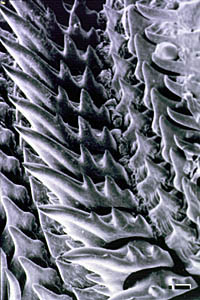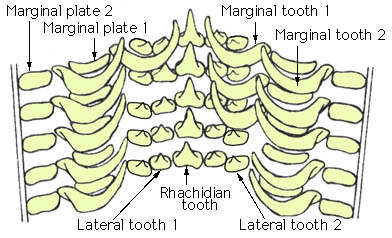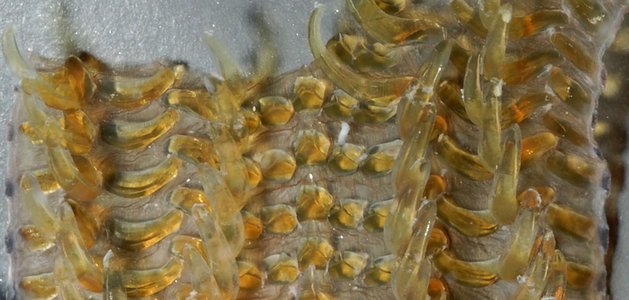Oh my goodness! Unless you are a Tree of Life developer,
you really shouldn't be here. This page is part of our beta test site, where we
develop new features for the ToL, often messing up a thing or two in the
process. Please visit the official version of this page, which is available
here.
Cephalopod Radula
Richard E. Young, Michael Vecchione, and Katharina M. Mangold (1922-2003)
Cephalopoda Glossary
The radula of neocoleoid cephalopods consists of a maximum of nine elements. The terminology is shown here for the two basic types of decapodiform radulas, the heterodont radula with more than one cusp on the rhachidian tooth and, usually, the first lateral teeth and the homodont radula with a single cusp on all teeth. Many modifications to the basic pattern exist. One of the most peculiar is the "ctenoglossan" radula of bolitaenid octopods in which all lateral teeth are multicuspid.

Click on an image to view larger version & data in a new window

Figure. Left: Thysanoteuthis rhombus, modified from Naef, 1923. Right: Sepia orbignyana, modified from Naef, 1923.
Many octopods have a peculiar type of heterodont radula in which the cusps of rhachidian tooth vary from one tooth to the next in a sequential manner. This arrangement is called seriation and results in a serial repetition along the radula. The number of teeth representing a series varies with the species but commonly the fifth tooth will resemble the first (see illustration on the left). The seriation can involve either asymmetrical (left drawing) or symmetrical (right drawing and the scanning electron micrograph) rhachidian teeth.

Click on an image to view larger version & data in a new window


Figure. Rachidian teeth. Left - Octopus vulgaris. Drawing modified from Nixon, 1995. Middle - Octopus macropus. Drawing modifed from Nixon (1995). Right - Octopus sp. Scanning electron micrograph by Mark Norman.
The radulas of Nautilus spp. are more complex than in the members of the Neocoleoidea. A total of 13 elements is present. The illustration on the right has attempted to clarify the arrangement by the elimination of the first marginal tooth from a number of the rows.

Click on an image to view larger version & data in a new window

Figure. Radula of Nautilus pompilius. Drawing modified from Naef (1923).

Click on an image to view larger version & data in a new window

Figure. View of a portion of the radula of Nautilus sp.. Compare with drawing above. Photograph by R. Young.
References
Naef, A. (1921/23). Cephalopoda. Fauna und Flora des Golfes von Neapel. Monograph, no. 35. English translation: A. Mercado (1972). Israel Program for Scientific Translations Ltd., Jerusalem, Israel. 863pp., IPST Cat. No. 5110/1,2.
Nixon, M. 1995. A nomenclature for the radula of the Cephalopoda (Mollusca) - living and fossil. Jour. Zool., London, 236: 73-81.
About This Page

University of Hawaii, Honolulu, HI, USA

National Museum of Natural History, Washington, D. C. , USA
Katharina M. Mangold (1922-2003)

Laboratoire Arago, Banyuls-Sur-Mer, France
Page copyright © 2000 , , and Katharina M. Mangold (1922-2003)
 Page: Tree of Life
Cephalopod Radula
Authored by
Richard E. Young, Michael Vecchione, and Katharina M. Mangold (1922-2003).
The TEXT of this page is licensed under the
Creative Commons Attribution-NonCommercial License - Version 3.0. Note that images and other media
featured on this page are each governed by their own license, and they may or may not be available
for reuse. Click on an image or a media link to access the media data window, which provides the
relevant licensing information. For the general terms and conditions of ToL material reuse and
redistribution, please see the Tree of Life Copyright
Policies.
Page: Tree of Life
Cephalopod Radula
Authored by
Richard E. Young, Michael Vecchione, and Katharina M. Mangold (1922-2003).
The TEXT of this page is licensed under the
Creative Commons Attribution-NonCommercial License - Version 3.0. Note that images and other media
featured on this page are each governed by their own license, and they may or may not be available
for reuse. Click on an image or a media link to access the media data window, which provides the
relevant licensing information. For the general terms and conditions of ToL material reuse and
redistribution, please see the Tree of Life Copyright
Policies.













 Go to quick links
Go to quick search
Go to navigation for this section of the ToL site
Go to detailed links for the ToL site
Go to quick links
Go to quick search
Go to navigation for this section of the ToL site
Go to detailed links for the ToL site